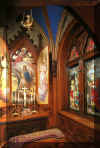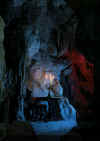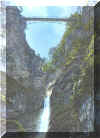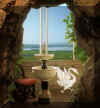Neuschwanstein CastleThe castle of Neuschwanstein (3306 feet above see-level) is built in the style of the late romanesque period of the early 13th century. This style is obvious in the construction of the building as a whole as well in its ornamentation: the round arched portals, the arcade windows and towers, the position of columns and its bay windows and pinnacles. The King's living quarters and representational rooms in the third and fourth floor were more or less completed by 1886. The rooms on the second floor are still in bare brickwork an not accessible. The Entrance Hall , Throne-Room , Dining Room , Bedroom , Chapel , Dressing Room , Living Room, Grotto and winter garden, Study, Singer's Hall, Kitchen, Marienbrücke |
|
The Entrance HallThe Entrance hall is divided into two aisles. Groined vaults adorned with decorative paintings, floor covered with tiles from Mettlach. To the left of the corridor, behind round-arched double windows, are the servants' quarters.
|
|
Throne-RoomThe Throne-Room was created as the Grail-Hall of Parsifal. It was designed in elaborate
Byzantine style by Eduard Ille and Julius Hofmann. Inspired by the Hagia Sophia in
Constantinople (now Istanbul), the 2-story Throne Room with its series of pillars of
imitation porphyry and lapis lazuli, was completed in the year of the king's death, 1886. |
|
 |
Dining RoomThe Dining Room of carved oak is decorated with paintings by Ferdinand von Piloty and Josef Aigner. They present figures from the "Minnesinger" period and scenes from the Wartburg Castle at the time of the legendary Song Contest in 1207. Over the door to the right is Wolfram von Eschenbach, the author of "Parzival" and "Lohengrin". The interior design of the room is by Julius Hofmann. The table sculpture, over 1 meter high, shows Siegfried fighting the dragon - a gift from Munich artists to Ludwig II. |
 |
BedroomIn contrast to the other rooms, the Bedroom is sumptuously carved in the Neo-Gothic style. 14 woodcarvers are said to have worked 4½ years to create this room. The Monarch's bed is covered with richly embroidered draperies. The wall paintings illustrate the "Tristan and Isolde" story, a story which, in Wagner's operatic realization, had deeply impressed he 20 year old King. A stream above the castle brings flowing water directly to the washstand. |
 |
ChapelAdjoining the bedroom is the small Chapel, dedicated to the Patron Saint of the King - Louis IX of France (St. Louis). The richly carved winged-altar is set into the decorated wall, and the altar paintings show scenes from the life of St. Louis. The stained glass windows to the right show St. Louis receiving the last sacraments. The windows are the work of the "Mayerischen" Court Art-Studio. |
 |
Dressing RoomThe dressing Room is completed in relatively simple oak paneling, and the trellis-work painted on the ceiling gives the impression of the room opening to the sky. The wall paintings illustrate the life and work of Walther von der Vogelweide and Hans Sachs - after the "Siegfried" motives of the Entrance Hall, and the "Tristan" motives of the Bedroom, this room is given over to the world of the "Mastersinger" period. |
 |
Living RoomThe richly decorated Living Room with its extension chamber, the so-called "Swan's
Corner", is completely dedicated to the legend of the Swan Knight Lohengrin - a saga
of great meaning and importance for Ludwig II. |
 |
Grotto and winter gardenBetween the Living Room and the Study Ludwig II had an artificial stalactite cavern built. These were in romantic vogue at that time. The landscape sculptor, Dirrigl from Munich, who had also built the grotto in the park of Schloss "Linderhof", built this grotto out of oakum and plaster-of-Paris, which has an artificial waterfall and which, with its illumination from above, is very effective.As one goes out of the grotto, immediately to the right, after the Living Room, one comes to the entrance to the Winter Garden which is closed off by means of a glass door, sunk into the rock. The fountain in the Winter Garden was originally intended for the second floor. There it was to have graced a Moorish hail (with the Alhambra in Granada as its model). Because of the ceasing of the building work, with The Moorish hall not being built this fountain was placed in the Winter Garden. As in Wagner's opera "Tannhäuser", the grotto was to have represented the introduction to the study, in which room the painting of the legend is to be seen. |
 |
StudyThe Gothic-styled Study of the King is stamped with references to the history of the Wartburg Castle. The paintings, set in finely carved wall panels, are carried out on Gobelin canvas by Josef Aigner and illustrate the Tannhäuser saga and the Song Contest of the Wartburg. |
 |
Singer's HallThe Singer's Hall occupies the entire 4th floor of the castle and is a copy of the
Minstrels Hall of the Wartburg Castle in Thuringia, designed by Julius Hofmann. The murals
in the hall and in the corridor depict scenes from the "Parzival" saga of the
middle-ages, which were, to a certain extent, incorporated by Wagner in his Sacred
Festival-Drama Parsifal. |
 |
KitchenThe completely intact Kitchen shows how modern technology was allowed to take its place whitin the atmosphere of the middle ages captured in the upper stories. The elaborate equipment includes hot and cold running water, and automatic spit roasters. |
 |
MarienbrückeThe romantic landscape of the castles surroundings can be fully appreciated looking from the bottom of the Pöllat Gorge up to the 92 meter Marienbrücke, a cantilever bridge spanning the 45 meter high waterfall. The bridge, orginally of wood, was named after Ludwig's mother, Queen Marie, a Prussian princess. In 1866 the present iron construction replaced the wooden bridge. |
All trademarks or product names mentioned herein are the property of their respective owners.





